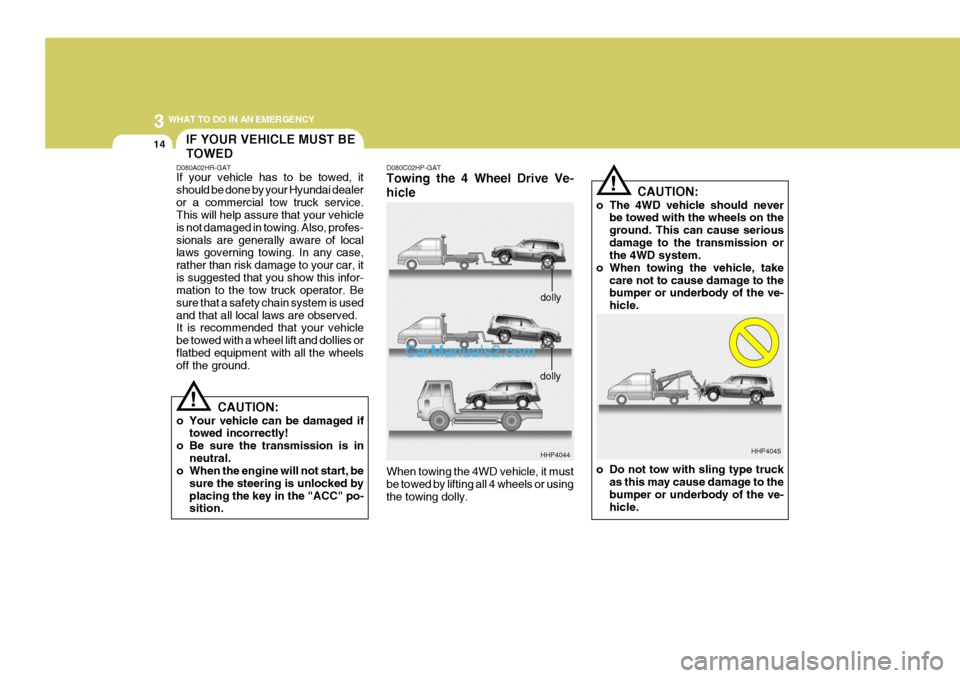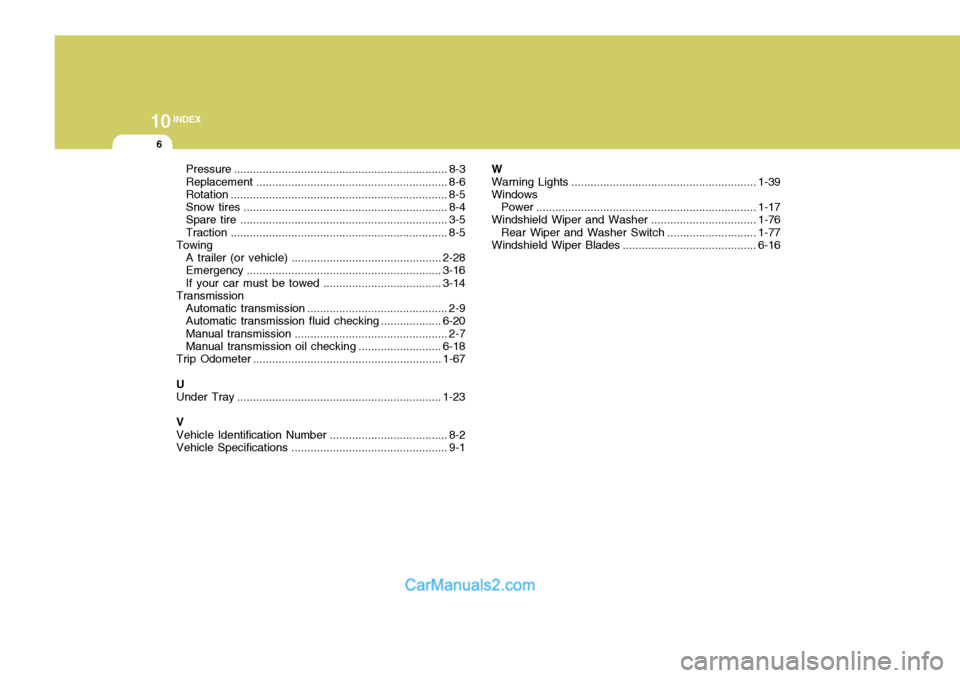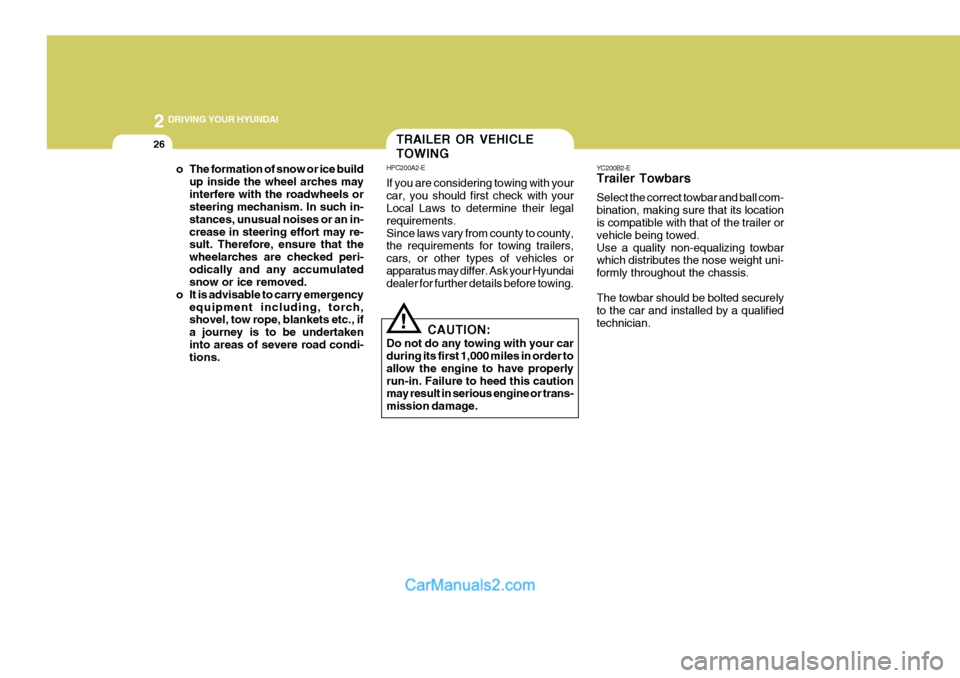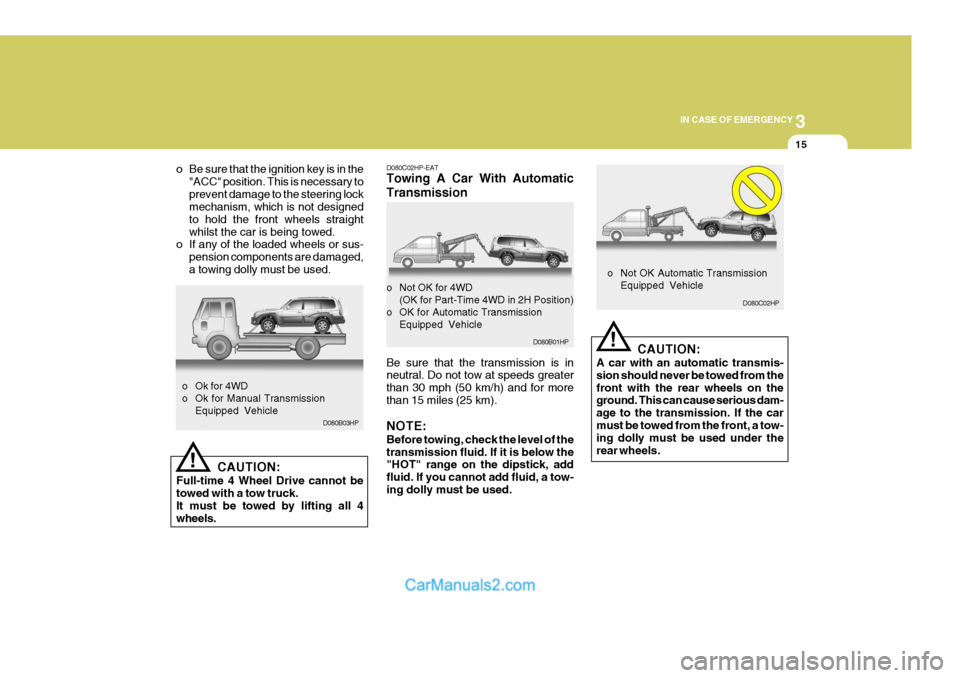Page 188 of 539
3
If the Engine Will not Start .......................................... 3-2
Jump Starting .............................................................. 3-3
If the Engine Overheats .............................................. 3-4
Spare Tire .................................................................... 3-5
If You Have a Flat Tire ................................................ 3-7
Changing A Flat Tire ................................................... 3-7
If Your Vehicle Must Be Towed .................................3-14
Emergency Towing .................................................... 3-15
If You Lose Your Keys .............................................. 3-16
WHAT TO DO IN AN EMERGENCY
3
Page 201 of 539

3 WHAT TO DO IN AN EMERGENCY
14IF YOUR VEHICLE MUST BE TOWED
D080A02HR-GAT If your vehicle has to be towed, it should be done by your Hyundai dealeror a commercial tow truck service. This will help assure that your vehicle is not damaged in towing. Also, profes-sionals are generally aware of local laws governing towing. In any case, rather than risk damage to your car, itis suggested that you show this infor- mation to the tow truck operator. Be sure that a safety chain system is usedand that all local laws are observed. It is recommended that your vehicle be towed with a wheel lift and dollies orflatbed equipment with all the wheels off the ground.
! CAUTION:
o Your vehicle can be damaged if towed incorrectly!
o Be sure the transmission is in
neutral.
o When the engine will not start, be
sure the steering is unlocked by placing the key in the "ACC" po- sition. CAUTION:
o The 4WD vehicle should never be towed with the wheels on the ground. This can cause seriousdamage to the transmission or the 4WD system.
o When towing the vehicle, take
care not to cause damage to thebumper or underbody of the ve- hicle.
!
HHP4045
o Do not tow with sling type truck as this may cause damage to the bumper or underbody of the ve- hicle.
D080C02HP-GAT Towing the 4 Wheel Drive Ve- hicle
HHP4044
When towing the 4WD vehicle, it must be towed by lifting all 4 wheels or usingthe towing dolly. dolly
dolly
Page 202 of 539

3
WHAT TO DO IN AN EMERGENCY
15
NOTE:
o To do the emergency towing, first
remove the cover below the bumper on passenger's side by pulling it
o To avoid serious damage to your
4WD vehicle, limit the towing to15 km/h (10 mph) and not for more than 1.5 km (1 mile) at ANYTIME.
o Before towing, check the level of
the automatic transmission fluid.If it is below the "HOT" range on the dipstick, add fluid. If you can- not add fluid, a towing dolly mustbe used. HHP4037
For emergency towing when no com-mercial tow vehicle is available, attacha tow cable, chain or strap to one of the towing hooks under the front/rear of your car. Be very careful when at-tempting this procedure when the ve- hicle is on any unpaved surface to avoid damage to your vehicle.Nor should towing be attempted if the wheels, drive train, axles, steering or brakes are damaged. Before towing,be sure the transmission is in neutral and the key is in "ACC" (with the engine off) or in the "ON" position (withthe engine running). A driver must be in the towed car to steer it and operate the brakes.
D080D03HP-GAT Emergency Towing
Front
HHP4035
HHP4036
Rear
Page 293 of 539

10INDEX
6
Pressure ................................................................... 8-3
Replacement ............................................................ 8-6
Rotation .................................................................... 8-5
Snow tires ................................................................ 8-4
Spare tire ................................................................. 3-5
Traction .................................................................... 8-5
Towing
A trailer (or vehicle) ............................................... 2-28
Emergency ............................................................. 3-16
If your car must be towed .....................................3-14
Transmission
Automatic transmission ............................................ 2-9
Automatic transmission fluid checking ...................6-20
Manual transmission ................................................ 2-7
Manual transmission oil checking .......................... 6-18
Trip Odometer ........................................................... 1-67
U Under T ray ................................................................ 1-23
V Vehicle Identification Number ..................................... 8-2
Vehicle Specifications ................................................. 9-1 WWarning Lights
.......................................................... 1-39
Windows
Power ..................................................................... 1-17
Windshield Wiper and Washer................................. 1-76
Rear Wiper and Washer Switch ............................1-77
Windshield Wiper Blades ..................... ..................... 6-16
Page 439 of 539

2 DRIVING YOUR HYUNDAI
26
YC200B2-E Trailer Towbars Select the correct towbar and ball com- bination, making sure that its location is compatible with that of the trailer or vehicle being towed.Use a quality non-equalizing towbar which distributes the nose weight uni- formly throughout the chassis. The towbar should be bolted securely to the car and installed by a qualifiedtechnician.
!
o The formation of snow or ice build
up inside the wheel arches may interfere with the roadwheels or steering mechanism. In such in- stances, unusual noises or an in-crease in steering effort may re- sult. Therefore, ensure that the wheelarches are checked peri-odically and any accumulated snow or ice removed.
o It is advisable to carry emergency equipment including, torch,shovel, tow rope, blankets etc., if a journey is to be undertakeninto areas of severe road condi- tions. CAUTION:
Do not do any towing with your carduring its first 1,000 miles in order to allow the engine to have properlyrun-in. Failure to heed this caution may result in serious engine or trans- mission damage.
TRAILER OR VEHICLE TOWING
HPC200A2-E If you are considering towing with your car, you should first check with your Local Laws to determine their legal requirements.Since laws vary from county to county, the requirements for towing trailers, cars, or other types of vehicles orapparatus may differ. Ask your Hyundai dealer for further details before towing.
Page 445 of 539
3
If the Engine Will Not Start .......................................... 3-2
Jump Starting .............................................................. 3-3
If the Engine Overheats ............................................... 3-4
Spare Tyre ................................................................... 3-6
In the Event of a Puncture ........................................... 3-7
Changing a Flat Tyre ................................................... 3-7
If Your Car Must Be Towed ........................................3-14
Emergency Towing ..................................................... 3-16
If You Lose Your K eys ................................................ 3-17
IN CASE OF EMERGENCY
3
Page 458 of 539

3 IN CASE OF EMERGENCY
14
!
CAUTION:
Your car can be damaged if towed incorrectly! If your car has to be towed, it should be done by your Hyundai dealer or a com- mercial tow truck service. This will help assure that your car is not damaged intowing. Also, professionals are gener- ally aware of local laws governing tow- ing. In any case, rather than risk dam-age to your car, it is suggested that you show this information to the tow truck operator. Be sure that a safety cablesystem is used and that all current laws associated with vehicle towing are ob- served. D080B01HP-EAT Towing a Car With Manual Trans- mission
D060J02O-EAT AFTER CHANGING WHEELS If you have a tyre gauge, remove the valve cap and check the air pressure.If the pressure is lower than recom- mended, drive slowly to the nearest service station and inflate to the cor-rect pressure. If it is too high, adjust it until it is correct. Always reinstall the valve cap after checking or adjustingtyre pressure. If the cap is not re- placed, air may leak from the tyre. If you lose a valve cap, buy another andinstall it as soon as possible. After you have changed wheels, al- ways secure the flat tyre in its placeand return the jack and tools to their proper storage locations.
HHP5019
IF YOUR CAR MUST BE TOWED
HHP4031
D080A02A-EAT
o Not OK for 4WD
(OK for Part-Time 4WD in 2H Position)
o OK for Manual Transmission Equipped Vehicle
D080B02HP
D080B01HP
o Not OK for 4WD (OK for Part-Time 4WD in 2H Position)
o OK for Manual Transmission Equipped Vehicle
Page 459 of 539

3
IN CASE OF EMERGENCY
15
o Be sure that the ignition key is in the "ACC" position. This is necessary to prevent damage to the steering lock mechanism, which is not designed to hold the front wheels straightwhilst the car is being towed.
o If any of the loaded wheels or sus-
pension components are damaged,a towing dolly must be used. D080C02HP-EAT Towing A Car With Automatic Transmission Be sure that the transmission is in neutral. Do not tow at speeds greater than 30 mph (50 km/h) and for morethan 15 miles (25 km). NOTE: Before towing, check the level of the transmission fluid. If it is below the "HOT" range on the dipstick, add fluid. If you cannot add fluid, a tow-ing dolly must be used.
!
CAUTION:
A car with an automatic transmis- sion should never be towed from thefront with the rear wheels on the ground. This can cause serious dam- age to the transmission. If the carmust be towed from the front, a tow- ing dolly must be used under the rear wheels.
D080B03HP
o Ok for 4WD
o Ok for Manual Transmission
Equipped Vehicle
! CAUTION:
Full-time 4 Wheel Drive cannot be towed with a tow truck. It must be towed by lifting all 4 wheels.
o Not OK for 4WD (OK for Part-Time 4WD in 2H Position)
o OK for Automatic Transmission Equipped Vehicle
D080B01HP
o Not OK Automatic TransmissionEquipped Vehicle
D080C02HP